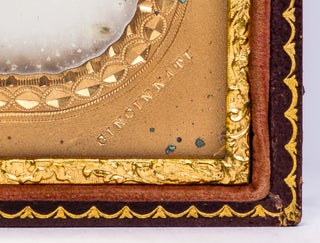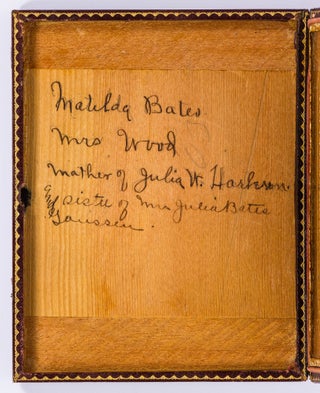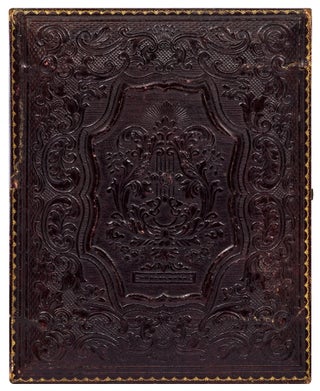Cincinnati: J.P. Ball, [circa 1855].
Sold
Unbound. Half plate daguerreotype of Mary Matilda Bates Wood Laboiteaux. Approximately 4.75" x 6". A couple spots of tarnish on the plate around where her bracelet and locket have been hand tinted with gold, otherwise bright and near fine in original near fine embossed leather case lacking the cut velvet plush insert inside the front cover, and where the name of the subject is written in ink at a later date onto the revealed wood: "Matilda Bates. Mrs. Wood, Mother of Julia W. Harbeson[?] and sister of Mrs. Julia Bates Garisseu[?]."
The name of the daguerreotypist "J. P. Ball" and "Cincinnati" are stamped on the brass mat. Ball was one of only a handful of known African-American photographers (along with Augustus Washington, Jules Lion, Glenalvin Goodridge, and John B. Bailey) who professionally produced daguerreotypes in the 1840s and 1850s.
According to Blackpast.org, Ball was born in Virginia in 1825, probably as a freeman, and "As a young man... learned daguerreotyping and opened his first studio in Cincinnati, Ohio at age twenty. The city was a center for anti-slavery activity as well as the photographic arts, and Ball became a leader in both... [and] ...he wrote and published a pamphlet depicting the horrors of slavery to accompany a large panorama in his gallery. By the 1850s, his business had achieved tremendous success... Frederick Douglass, Jenny Lind, and the orator Henry H. Garnet, among other notables, sought out his services... ."
Ball eventually moved to Minneapolis in the 1870s, ran a photography studio there, and in about 1887, he went to Montana with his son James Presley Ball, Jr., where he opened another photography studio in Helena. Ball’s son edited a newspaper, *The Colored Citizen,* an early source of information on African-American life in territorial Montana. He moved to Seattle around 1900 and eventually moved to Hawaii for his health where he died in 1904.
Daguerreotypes were only commercially produced for about two decades, when images on treated paper largely replaced them. In Ball's 60-plus-year career, he only produced dags for about 15 of them. Not surprisingly, most of Ball's subjects were white. The subject, Matilda Barts, died of consumption in Hamilton County, Ohio in 1858 at the age of 32.
Ball's dags are avidly sought after, with the Schomburg Center for Research in Black Culture, Cincinnati Art Museum, Cincinnati Historical Society, George Eastman House, Library of Congress, Montana Historical Society, Ohio State University, and University of Washington all holding examples. Most of his dags were sixth or quarter plates, half plates are exceptionally uncommon.
Item #426640






